Ganguly fires, ICC misfires
Cricinfo writers select their best and worst moments from 2006
Martin Williamson
|
|
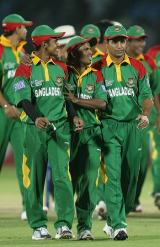
|
Bangladesh, so long the whipping boys of international cricket, have enjoyed handing out some drubbings of their own and ended the year flushed with success after 12 wins in 14 ODIs - their previous 129 ODIs had brought just 16 victories. While the opposition were not top class, Bangladesh more than underlined that they have opened a wide gap between themselves and the chasing pack. Although restricted to two Tests by the grossly imbalanced Future Tours Programme, they gave Australia some sleepless nights - and almost a follow-on - before the pressure got to them. Their aim in 2007 is to pick off the sides in eighth and ninth in the ODI rankings ... England and Sri Lanka.
Speaking of the gap between the best and the rest, 2006 was the year in which the ICC's brave new (albeit under-funded) plan to allow the top six Associates kicked in. However, there were no surprises, although Kenya hinted at what we all suspected, namely they are the best of the rest, by drawing a series in Zimbabwe although they were trounced by Bangladesh. That aside, no upsets were threatened and some woefully one-sided games were also in evidence, none more than when Sri Lanka piled on 443 for 9. The biggest disappointments were the highly-funded Bermudans and the Scots, who were thrashed in Bangladesh in December. But the main problem was still that the big boys simply didn't want to play with the minnows whose appeal to sponsors and TV companies was zero.
Sriram Veera
|
|

|
It was all set up for a fall. The critics were chuckling quietly, "Ah ... He's going to get buried on the bouncy South African track." Obituaries were dusted up and one more line, describing his latest debacle, was about to be added. He made them look sheepish with a gutsy 87 against Rest of South Africa. And by the end of the first Test, he had converted a few of the critics to his side. Ridicule had made way for respect. 'Dada ki baat sunenge na?" he had cajoled us in an astounding advertisement that I can't believe any other cricketer would have done. He impressed with his desire, if not with the scores, by playing every Ranji Trophy match and surprised some of us, with his show in South Africa. The redemption song is on. How long it will last is anybody's guess but, briefly, at end of the year, when old dies for new, Sourav Ganguly gave us a lilting tune.
A little story first. During the ball-by-ball commentary of the second Test against South Africa in Durban, I had written this: "Two wickets down, in comes Sachin Ramesh Tendulkar. Another semi-crisis to deal with. The story of his life." Almost immediately, two feed-backers pinged me with, "Story of Sachin's life you said? How many times did he rescue India out of crisis? What a statement?"
Peter English
|
|

|
Stuart Clark waited until he was 31 to make his mark on Australian cricket with a Man-of-the-Series performance against South Africa. A useful fast bowler for New South Wales, he quickly became a stand-out for Australia with his nine wickets on debut at Cape Town. Twenty dismissals came in his first series and his continued strong performances have shown there will be life after Glenn McGrath.
John Buchanan's boot camp might have bonded Australia's contract-holders successfully, but it pushed Michael Kasprowicz to consider retirement. Kasprowicz could cope with the various tasks, but he suffered a groin injury that later flared into a painful back problem and he is still waiting to return to domestic action. John Buchanan rated the camp as one of his greatest achievements, but it has almost certainly led to the end of Kasprowicz's international career. Stuart MacGill, who suffered a knee problem during the week, has also not appeared for Australia since the pre-season activity.
Nishi Narayanan
|
|
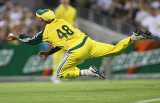
|
If like the movies we could flashback a cricketer's life in quick rewind to 'where it all came together', Michael Hussey's catch to dismiss Ashwell Prince in the second match of the VB series this year, would be such a moment. Hussey ran in from mid-wicket to square leg with his left hand out. He stretched a little more than one's imagination could and flung himself towards the ball. The scoreboard innocuously read Prince c Hussey b McGrath 19. Hussey had played 22 ODIs before the one at the Gabba and in three months into his Test career he had three hundreds and was already a 'find of the year'. But the catch was the moment it all fit into place. No turning back from there. An ODI average of 77.11 and with four fifties and a hundred from six Ashes innings he is now on full fast-forward mode.
One had to tune into this one - Greg Chappell coaching Sourav Ganguly on playing the short ball - a nicely packaged 'unrehearsed' video of the coach and batsman in the nets going over the processes of hooking and pulling. Then Sunil Gavaskar, a commentator on the channel which broadcast these exclusive videos, gave Rahul Dravid some batting tips and Allan Donald, also a commentator, had a friendly chat with Indian bowlers Sreesanth and VRV Singh. As televisions were switched on to watch the fourth day of the Durban Test, Sreesanth and VRV stood awkwardly by the camera while Donald advised Sreesanth not to lose his cool on the field. Painful to watch, it reminded one of a teacher reprimanding a student while the rest of the class listened in. More painful was Harsha Bhogle's claim that the best reality tv is that which is spontaneous. There have been worse moments this year, but nothing so cringe-worthy.
Sambit Bal
South Africa's chase of 434 at Johannesburg was breathlessly described by many, including Cricinfo, as the greatest one-day match ever. But I must admit that it made me queasy. It was, without doubt, the most incredible chase and a spectacle. But it was hardly a match. On that pitch and with those short boundaries, the bowlers didn't have a chance.
Paul Coupar
|
|
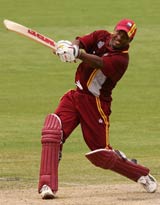
|
Perhaps it was the tantalising mirage of the Aussies being made to look mortal ahead of the Ashes. Perhaps it was because I was puffing on a gym treadmill at the time and appreciated a distraction - any distraction. But watching Lara's front-foot pull for six, during the Champions Trophy clash at Mumbai, to a ball most would have nurdled through third man, was truly electric. More risky than Dravid, more inventive than Ponting, he remains thrilling to watch.
Every serious Test nation will be playing, with Bangladesh hosting a major series against Scotland. It's far, far too much cricket. It's dulling our appetite and the sharpness of our memories. It's weakened competition and diluted fine performances. Cricket becomes a meaningless blur.
Anand Vasu
|
|

|
They say subjects get the kings they deserve. But sometimes you are left wondering if India's cricketers get the fans they deserve - not quantity, but quality wise. One of the more distressing sights is watching Sachin Tendulkar fielding on the fence at an Indian ground and getting booed and barracked for not having made runs in a game. Cowards who yell anonymously from a group are one thing, but in Guwahati, when the appalling side of fan behaviour reached its crescendo. After no play was possible because heavy overnight rains had drenched the ground, even the most desperate attempts of the organisers failed. Angry fans rioted, destroying equipment, breaking down fences and walls, assaulting security personnel. Blood was shed and tear gas cannisters were fired. Riots and violence of this kind remind of all the things that are wrong in this world - communal violence, dictatorial oppression, that sort of thing. It's the sort of thing I never expected to see at a cricket ground, and hope I never have to write about again.
Sam Collins
As the vultures hovered over Duncan Fletcher at Perth, Ian Bell's treatment of Shane Warne in his spunky 87 drew attention to the many positive aspects of the coach's reign. Bell, for so long the golden-child of English cricket, had been comprehensively worked over by Australia in 2005 and a spell on the sidelines followed. However, rather than join the lost generation of Ramprakash, Hick and Crawley he seized the second chance afforded him by Flintoff's injury, and three hundreds against Pakistan signalled that in this England set-up players do not wither when dropped, they fight back.
|
|
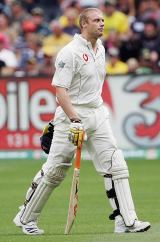
|
Steven Lynch
|
|

|
It's one thing for a spinner to grab the wicket of an out-of-form batsman, or a wide-eyed rabbit. But the ball which announced Monty Panesar as a bowling star of the first magnitude was to a batsman at the top of his form, fresh from 173 in the first innings at Headingley. The recipient was Younis Khan, half of Pakistan's Two Ys batting pairing which troubled England all summer. Panesar dragged Younis forward, beat his jabbed defensive push, and the ball snaked back from the rough outside leg, just kissing the top of off stump and flicking the bail. It was a great delivery - one that should have been played on a continuous loop in a locked room to the England tour selectors before they made the ruinous decision to leave Panesar out of the Brisbane and, especially, Adelaide Tests against Australia.
Actually I wouldn't have minded Australia winning the Ashes, as long as it had been a decent series. And when England rolled past 500 in the second Test at least it looked as if the series would be still alive come Christmas. That predictable first-up defeat at Brisbane wouldn't have looked quite so bad if it had been followed by a strong draw - or even a surprise victory - at Adelaide. But then came that peculiar declaration-by-numbers, the expensive drop of Ponting ... and the strokeless collapse on the fifth day that gave Australia the chance of victory, which they greedily guzzled. If Australia had won the Edgbaston Test in 2005, and gone two up, it would have ruined the "Greatest Ever" Ashes series: their victory here killed this one stone dead. There was never any way back from 2-0.
Brydon Coverdale
|
|
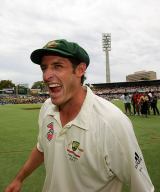
|
Michael Hussey is not Don Bradman. Statistically, however, he is pretty darn close. Few players have taken to Test cricket as quickly and impressively as Hussey, who Australia have discovered can plug any hole in the top six. Sadly, there is only one of him, because there could be a few leaks soon if any more batsmen call it a day. After 14 Tests, he averages 86.33 - Bradman averaged 94.45 at the same point in his career. Hussey's average will almost certainly decline but Australia's No. 4 spot is definitely in safe hands. Suggestions have even been made that Australia might not have lost the Ashes in 2005 had he played. That might be drawing a long bow, but his class and composure has been patently obvious in 2006.
Australian cricket fans considered losing the Ashes in 2005 a calamity. They probably should be thankful, however, because it postponed for just over a year the moment they would regard as an even bigger tragedy - Shane Warne's retirement. He would have quit had Australia retained the Ashes last year but his total commitment to regaining the urn pushed him on to 2006-07. Warne's departure was a desperately sad moment for world cricket because his complete mastery of legspin is as unlikely to be replicated as a Jason Gillespie double-century. There have been plenty of stars in world cricket in the past 20 years but few towering legends of the game. Warne is unquestionably one of them.
Vaneisa Baksh
|
|
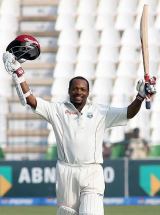
|
West Indies sank to the debacle between Allen Stanford and the West Indies Cricket Board (WICB) over the clash between fixtures for his Super Star tournament (Nov 10-12) and the West Indies tour of Pakistan. Discussions began early in the year between the parties, but somewhere wires got crossed and what was represented as a hardline position from the Pakistan board turned out to be flexible, but only after the tournament had been called off by an irate Stanford. A possible five million US dollars to South Africa was lost in the rush, while the WICB claimed that Stanford had backed out of a promised US $2 million donation.
Siddhartha Vaidyanathan
|
|

|
This was the one-day version of Steve Harmison's short ball to Michael Kasprowicz at Edgbaston. Ten needed off the last five, Bravo to Yuvraj, and Sabina Park is going delirious. A top-edged four sends down shivers and a blistering cover-drive that follows induces a sense of utter hopelessness. In a couple of minutes, a cheering arena was turned into a morgue. Two off three was too easy. India were going 2-0 up in a five match series and Windies were all but buried.
Strangely the Iqbal Stadium was full, on a the fifth day of a quite meaningless Test. A grand total of 1702 runs were scored in five days and chances of a result were as remote as Shoaib Akhtar embracing Mahendra Singh Dhoni. Then Afridi entered and, after an innings lasting three balls, edged to the keeper. And then, in one mighty wave, Iqbal was empty. Barring two sessions on the third day, nobody needed have turned up for this batting orgy. Six centuries, five half-centuries, eight bowlers conceding more than 100, 200 fours, 27 sixes ... On a tar road masquerading as a pitch, cricket wept, wailed and finally died.
Anil Nair
|
|

|
Kevin Pietersen's continuing tirade against alleged racism in the land of his birth is a blot on his otherwise remarkable story of courage and adaptability. South Africa does have a skewed quota system in cricket, official protestations notwithstanding, and Pietersen obviously was a victim of it. But there is the larger reality and his phenomenal success as an England player ought to have made Pietersen realise that what goes around comes around too. In the new South Africa, violent crime and rape is rampant but it is also a great experiment in multiculturalism, where the unity is willed, still not quite on strong foundations but not a facade either: the power is with the blacks, the money largely white and the balance between empowerment and exploitation is ever so steadily shifting towards the former. To call such historical redress racism is simply diabolical, but in this case it appears more a matter of a challenged IQ.
Will Luke
Some have numbed Shane Warne's spitting legbreak but precious few have silenced his venomous tongue. Kevin Pietersen's direct, planned attack on Warne has been this series' mesmerising sideshow. He smashed him for six fours and a six - 59 out of his masterful 158 at Adelaide - leaving Warne bemused and becalmed. Warne got his revenge in the second innings, bowling him around his legs - but his and Australia's euphoric celebration said plenty. Finally, an Englishman who could match Warne's ability as a cricketer - and with verbals, too.
It was so depressingly inevitable. Wrongly chosen for the first Test, we hoped, a little naively, that Ashley Giles would be joined by Monty Panesar for the second at Adelaide. He wasn't. Giles dropped Ricky Ponting on 35 (he made 142); scratched around at Duncan Fletcher's precious No.8 position and bowled haplessly. Monty finally made his belated Ashes debut at Perth, took eight wickets and showed promising class and ability with the bat. Too late.
Jenny Thompson
|
|
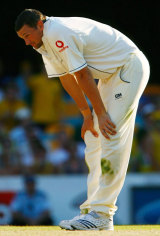
|
From the sublime to the ridiculed... England took fewer than 16 months to lose the Ashes they'd taken 16 years to regain - and poor Steve Harmison's first ball in the first Test at Brisbane set the tone. That wide was so wide it flew to Andrew Flintoff at second slip and at that point the England captain must have thought the urn could easily slip from their grasp. So it proved, with an out-of-sorts Harmison typifying England's woes. They did play well in parts, but not the vital ones, and Ponting had the Ashes all wrapped up for Christmas.
Sidharth Monga
Ali Hamid Zaidi had had nothing to do with Uttar Pradesh's Ranji campaign till the final, where he fielded as a substitute. The whole innings went without him having to do anything significant. Until Bengal were nine down and needed 15 runs to gain the first innings lead that would, in all probability, decide the Ranji Trophy final. For three days and a bit, the game had meandered towards this climax. The lack of action and pace could have been a good excuse for missing the defining moment when it came your way. Not for Zaidi.
Walking off after being bowled by Monty Panesar at the WACA, Justin Langer's attention was attracted by somebody from the crowd. To his credit Langer didn't say anything, didn't scream, but his look said it all. A disrespectful word from who could be a loser but thinks he is a hero, hiding in the crowd, is the last thing you would want to hear when you are walking back.
Charlie Austin
|
|
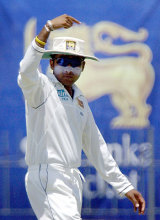
|
Call me old fashioned if you must, but I cherish cricket's long-held commitment to sportsmanship. The "Spirit of the Game" is a woolly concept, but it enshrines values of great importance. Brendon McCullum's run out of Murali during the first Test in Christchurch may have been lawfully correct, but it was wholly at odds with the spirit of the game.
Jamie Alter
|
|
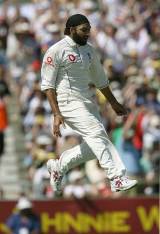
|
The lifting of the bans on Shoaib Akhtar and Mohammad Asif, after they had tested positive for banned steroid nandrolone. How a three-member panel was allowed to decide the verdict for a matter as serious as doping, and for a national federation such as the Pakistan board, to tell an international federation what rules it is going to apply for the controversial case, was shocking and unacceptable. The PCB-appointed tribunal acquitted Akhtar and Asif with the reasoning that they had not been warned about dietary supplements blamed for their positive tests. The bottom line is that they tested positive. Enough said, case closed. International athletes must be aware of the risks involved and a lack of knowledge was no excuse.
Andrew Miller
It looked like a vision of a glorious future when Steve Harmison and Monty Panesar combined their mercurial talents to deliver a remarkable innings-and-120-run victory against Pakistan at Old Trafford. England's odd couple thrived on a trampoline pitch to share 19 wickets between them - 50 years to the week since Jim Laker had managed that number all by himself, on the same ground. Teasing tweakers and menacing lift. It had a nation in raptures, in anticipation of similar conditions Down Under. Oh well ...
|
|
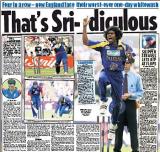
|
Where do we start with this one? That dismal 5-1 drubbing against India? That dismal 5-0 drubbing against Sri Lanka? That dismal and hollow victory over a hopeless Irish team at Stormont? That dismal capitulation against Australia at Jaipur. Dismal, dismal, dismal. England couldn't give a toss about one-day cricket this year. The Ashes (past and present) was all that mattered. Which is rather ironic, seeing as the disciplines and momentum that Australia carried over from their Champions Trophy triumph were precisely what seized that decisive final day at Adelaide.
Kanishkaa Balachandran
|
|

|
Rahul Dravid's twin half centuries on a minefield of a pitch in Jamaica highlighted the gulf between the good and the great. Dravid's impeccable technique and unfazed concentration combined to guide India to its Holy Grail - a Test series victory abroad against a credible opposition, which took 20 years of waiting. The innings was a throwback to an earlier era, as Dravid gritted it out on a two-paced pitch, cutting down on flamboyance and playing the ball on its merit. The fact that he faced more number of deliveries in his first-innings 81 than the West Indians did in their first-innings capitulation was an indication that it was one man against the rest.
India's hapless surrender for 100 in the final day of the final Test against England at Mumbai would rank high among the Test cricket's meek capitulations. The injury-hit Johnny-Cash inspired England side led by Andrew Flintoff were treated like royalty, as the Indians gifted away wickets at a frenetic pace, courtesy some diabolical shot selection. Relative unknowns and newcomers in international cricket had their moments under the sun, as did a certain Monty Panesar, who was given a second chance in the deep after dropping a sitter just two balls before. India renounced their stranglehold in the series, settling for a 1-1 draw after 49 overs of madness. Gracious hosts? Well done India...
Jayaditya Gupta
|
|
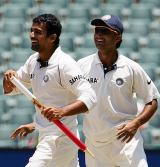
|
This was the year of the fightback. It happened with players - Zaheer Khan, Sourav Ganguly, Chamara Silva (whose match-winning century and half-century in Wellington came after a pair in Christchurch) - who defied the odds, conventional wisdom and the crushing weight of expectation to record personal landmarks. It happened with teams in a match situation; most famously, South Africa, who chased down Australia's 434 at the Wanderers; Australia themselves, who fashioned a victory out of sheer self-belief at Adelaide; Pakistan, recovering from Irfan Pathan's first-over hat-trick at Karachi. And in the context of a tradition: Australia again, for so emphatically winning back the Ashes.
The BCCI, like Topsy, just grow'd. And grow'd. And somewhere along the way the pounds, dollars, rupees and whatever other currency they were raking in, stopped making sense. Full credit to all those manning the bean counters but the list of things left undone is far too long: Rotting stadiums, a shoddily-run domestic structure, an overpowering stench of ad-hocism...and, above all, the belief that big bucks alone can change everything. It's a monopolist leviathan thriving in a free-market economy. Not much room for cricket there.
Dan Brigham
|
|

|
The crowd's gasp was as loud as it was revealing. Pietersen had just fallen after a breathtaking 142, and the crowd knew that some of the greatest, most creative hitting ever seen in a Test arena was at an end. Once regarded with suspicion by the English for his South African-ness and his love of celebrity, this magical innings famous for the left-handed sweep for six over point off Muralitharan changed all that.
England's preparations for retaining the Ashes were bad enough. Then someone took the ridiculous decision to fly the team home from India following their inept Champions Trophy showing rather than heading straight to Australia to prepare for the Ashes. There was everyone thinking this was the most important series since, well, Ashes 2005, and yet England were flying half-way around the world to spend a couple days at home before again flying half-way around the world. Was it vindicated? Was it hell?
Neil Manthorp
|
|
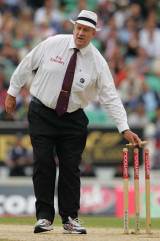
|
Mick Lewis (10-0-113-0): "It's not like I bowled a heap of pies. I actually bowled quite well. It was just one of those freaky games. I wouldn't have bowled 10 overs if I was bowling a heap of crap. I'm not a selector, but they're in the job for a reason, they're smart and I'm sure they don't just look at one game and say 'He's not up to it'." The game needs its comedians and delusionists.
The moment Darrell Hair's superiority complex and 'sense of theatre' over-ruled common sense and persuaded him to signal five penalty runs against Pakistan at the Oval. If only he had considered the consequences - or, at the very least, caught Inzamam with a pen knife and a bottle top in his pocket.
Andrew McGlashan
Every dog has its day and for Shaun 'Shaggy' Udal it couldn't have come much sweeter than the third Test against India at Mumbai. It was his last chance to make a mark in international cricket after being overlooked for the first two Tests following a poor tour of Pakistan. Shortly after lunch on the final day, Sachin Tendulkar propped forward and an inside edge popped to short leg and an hour later he'd help to wrap up a famous England victory. One to tell the grand kids about.
There has been plenty to bemoan about England's one-day cricket over the last 12 months, but Harmison's scatter-gun spells are up there with the worst moments - and they have infected his Test form. His mauling at the hands of Sanath Jayasuriya and Upul Tharanga at Headingley was the most damaging to his figures (0 for 97), but for his mental state his performance against Australia at the Champions Trophy had longer side-effects. It is time for him to leave the white ball behind.
Osman Samiuddin
|
|
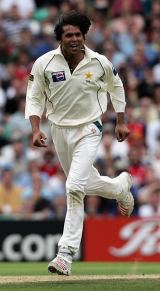
|
There existed few reasons for cheer during the summer tour to England. Through the series their batsmen battered Pakistan's bowlers. Kevin Pietersen wasn't the most successful but he went about it with a more brutal relish than any. He is, as Australia found out, a batsman designed to dominate. But where McGrath and Warne failed, Mohammad Asif prospered. In four matches after his belated return, Asif tormented Pietersen. Twice, he fell first ball and every other time cricket's pop idol was taunted, teased, set up and chicken-danced at before being sent back. Nobody has done it to him before or since. It was but an isolated symbol of resistance for Pakistan's bowling, but what a symbol.
Even by Pakistan's standards, this was a particularly shambolic fielding year. And slap, bang in the middle of it was Imran Farhat, the man Jonty Rhodes had tipped as the best catcher during a futile two-week stint as fielding consultant. The first thing Farhat did after Rhodes's tips was to drop three catches during the Lord's Test. The last thing he did before it was to drop chances in Sri Lanka. At slip, at point, at crucial stages, at irrelevant junctures, anywhere, anytime, Farhat spent the year shelling chance after chance, easy or difficult. At one point, it seemed he had dropped more catches than he had scored runs and if there was a record kept of these things, Pakistan would have had another record-breaker in their ranks. Jonty what were you thinking?
Edward Craig
|
|
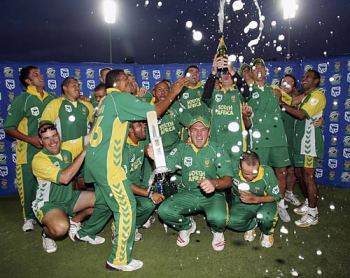
|
South Africa and Australia's record-breaking ODI at Johannesburg. It was gruesome, dirty, unfair cricket but completely absorbing. This was not the greatest game ever, not even close, but it was as exciting a spectacle as the sport can produce - the noise of the crowd, the buzz in the press box, the look of shock on people's faces as they left the ground. And the world champions lost. Brilliant.
The Champions Trophy - not because it was a superfluous tournament, an ICC cash cow clogging up the international fixture list - but because it wasn't the World Cup. This is the format and time-scale the World Cup should be played over. I'd even argue that these are the type of wickets the World Cup should be played on. Low-scoring ODIs are, on balance, more exciting than run-fests - a Johannesburg-type match every game (which is what the ICC want) would be very dull.
John Stern
|
|
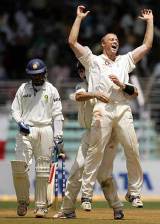
|
We know now that this Flintoff-fuelled comeback victory was not a turning point in England's mixed post-Ashes fortunes but a joyous blip in a miserable year. Inspired by their larger-than-life stand-in captain and his choice in music (Johnny Cash's Ring of Fire) England drew the three-match rubber by bowling India out for 100 on the final day. It was a day to be remembered for Monty holding a steepler to dismiss Dhoni two balls after he'd completely missed a similar chance and for the never-to-be-repeated scorecard entry: Tendulkar c Bell b Udal.
The departure of Marcus Trescothick from the England team (twice in eight months) has been a desperately sad affair. Sad for him and his family, sad for team-mates and supporters who harboured hopes of retaining the Ashes. But also sad because it has shown the ECB in its worst obfuscatory light.
George Binoy
|
|
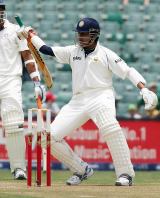
|
It's the second innings of the Johannesburg Test between South Africa and India. Andre Nel steams in to bowl his first ball at Sreesanth. He lets loose a bouncer and spouts his usual dose of verbal diarrhoea at Sreesanth who had hurried out of the way. We didn't have a clue to the scenes that would follow for Sreesanth's body language indicated nothing. Nel runs in to bowl his second ball. This time it isn't a bouncer, Sreesanth backs away again but flat-bats an astonishing six over long-off, an ungainly slog. His riposte doesn't end there for as he reaches the bowler's end he does something that is best viewed and not described. I hope more batsmen give as good as they get from Nel.
Not many will remember that 2006 was also the year that Bangladesh nearly derailed the Australian juggernaut. And it wasn't just a sliver of a chance. Bangladesh piled up 427 in the first innings and then secured a lead of 158. At one stage during the run-chase, Australia needed 76 with four wickets in hand. They were close to suffering the most humiliating defeat in history. And that prospect of seeing Goliath felled by David's little brother was mouth-watering. For who doesn't love supporting the underdog? Beating Australia in a one-day at Cardiff was surreal enough, but a Test win would have been ... But Ricky Ponting played spoilsport to millions of hopefuls like myself and scored a matchwinning hundred under circumstances where the humiliation of defeat weighed more heavily than the task at hand. Glorious uncertainty of sport? Bah humbug.